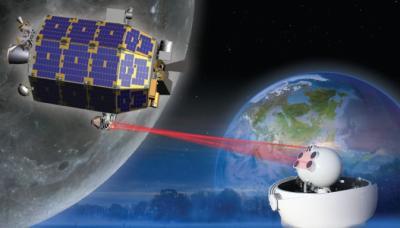The Lunar Laser Communication Demonstration (LLCD) on the Lunar Atmosphere and Dust Environment Explorer (LADEE) is going to show that two-way laser communication beyond Earth is possible, broadening the possibility of transmitting huge amounts of data.
In the future, this could allow for 3-D High Definition video transmissions from deep space missions back to Earth.
Much of NASA, like many government-controlled science and engineering, is still stuck in 1960s architecture, always creating a new Manhattan Project of X. This technology was instead created by the Massachusetts Institute of Technology Lincoln Laboratory to take the 1960s idea of space lasers and apply it to higher-resolution video. Since the earliest days of space exploration, radio frequency (RF) communication has been the default but RF has reached its limit while demand for more data capacity continues to increase. The development of laser communications will give NASA the ability to extend communication applications such as increased image resolution and even 3-D video transmission into deep space. LLCD is designed to be proof-of-concept and is NASA's first dedicated system for two-way communication using laser instead of radio waves.

Artistic rendering of the LADEE satellite in orbit. Credit: NASA
The European Space Agency already has successfully demonstrated laser communication between satellites in Earth orbit. Recently they launched Alphasat to demonstrate laser transmission between a low-earth orbit satellite and a satellite in geostationary Earth orbit. LLCD's laser link from the moon will be ten times farther away.
"The goal of the LLCD experiment is to validate and build confidence in this technology so that future missions will consider using it," said Don Cornwell, LLCD manager, in their statement. "LLCD is designed to send six times more data from the moon using a smaller transmitter with 25 percent less power as compared to the equivalent state-of-the-art radio (RF) system. Lasers are also more secure and less susceptible to interference and jamming."
Recently, an image of Leonardo da Vinci's painting, the Mona Lisa, was transmitted to NASA's Lunar Reconnaissance Orbiter (LRO) spacecraft orbiting the moon. "But this was done at only hundreds of data bits per second," said Cornwell. "LLCD will be the first dedicated optical communication system and will send data millions of times faster."
The LLCD experiment is hosted aboard NASA's LADEE: a 100-day robotic mission designed, built, integrated, tested and will be operated by Ames. LADEE will attempt to confirm whether dust caused a mysterious glow on the lunar horizon astronauts observed during several Apollo missions and explore the moon's tenuous, exotic atmosphere. Launch of the LADEE spacecraft is set for September aboard a U.S. Air Force Minotaur V rocket, an excess ballistic missile converted into a space launch vehicle and operated by Orbital Sciences Corp. of Dulles, Va., from NASA's Wallops Flight Facility on Wallops Island, Va.
The LADEE spacecraft will take 30 days to reach the moon because of its flight path. LLCD will begin operations shortly after arrival into lunar orbit and continue for 30 days afterward.
LLCD's main mission objective is to transmit hundreds of millions of bits of data per second from the moon to Earth. This is equivalent to transmitting more than 100 HD television channels simultaneously. LLCD receiving capability will also be tested as tens of millions of bits per second are sent from Earth to the spacecraft. These demonstrations will prove the technology for increased bandwidth for future missions is possible.
There is a primary ground terminal at NASA's White Sands Complex in New Mexico, to receive and transmit LLCD signals. The team at MIT designed, built, and tested the terminal. They also will be responsible for LLCD's operation at that site.
There are two alternate sites, one located at NASA's Jet Propulsion Laboratory in California, which is for receiving only. The other is being provided by the European Space Agency on the Spanish island of Tenerife, off the coast of Africa. It will have two-way communication capability with LLCD. "Having several sites gives us alternatives which greatly reduces the possibility of interference from clouds," said Cornwell.
LLCD is a short duration experiment and the precursor to NASA's long duration demonstration, the Laser Communications Relay Demonstration (LCRD). It also is a part of the agency's Technology Demonstration Missions Program, which is working to develop crosscutting technology capable of operating in the rigors of space. LCRD is scheduled to launch in 2017.
NASA engineers believe this technology becomes even more advantageous for communications beyond Earth's orbit. In the past, NASA has experimented with sending low amounts of individual pulses to cameras on far-away space probes near Jupiter, Mars, and Mercury.
NASA is looking upon laser communication as the next paradigm shift in future space communication, especially deep space. "We can even envision such a laser-based system enabling a robotic mission to an asteroid," said Cornwell. "It could have 3-D, high-definition video signals transmitted to Earth providing essentially 'telepresence' to a human controller on the ground."






Comments